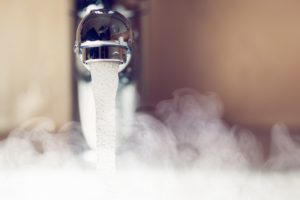
There’s nothing worse than getting ready for a nice hot soak only to discover you’re in the midst of a cold water shower. If things simply never heat up, it’s probably because your water heater has been working overtime and needs time to regenerate. But if your hot water shower turns suddenly chilly, the problem may lay within the unit itself. Here is a quick way to solve any hot water shower troubles.
Water Heater Problems
First, check all your fixtures throughout the house to see if your cold water shower is a singular problem or a whole-house situation. If none of the plumbing allows hot water to pass, then the problem is your water heater. Check the temperature control on the unit to see if the setting is ideal. Next, check to see if it’s blown a fuse. If you have a gas unit, it could be that the pilot light has blown out, in which case you should relight it following the manufacturer’s instructions. However, if there is still no sign of a hot water shower after the pilot has been relit, then you may have a variety of problems: obstructions in the flue, a defective part (often the thermocouple), a faulty temperature control, sediment buildup, etc. For any of these more complex replacement projects and repairs, always hire a heating professional who can diagnose and fix the problem quickly and efficiently.
Hot Water Showers: An Isolated Incident
Once you check out other fixtures in the home, you may find it’s just your bath stall that’s suffering from sudden cold water showers. Luckily, if it’s a newer home, you won’t have to worry about replacing the pipes since the possibility of stoppage or obstructions in copper systems are rare. Unlike older galvanized steel pipes, copper pipes rarely corrode on the interior, and therefore, other than some minor oxidation, the piping stays free-flowing. First, find the shut off valve for the hot water and see if it’s closed. If so, opening the valve could remedy the situation. But if the water still remains warm for only short periods of time, you may have a problem with your bathroom shower valve.
Remove, Rinse, and Replace
When the rubber parts in the shower valve get worn and distorted from old age, they can swell up and restrict the waterways. This swelling only increases as the water temperature traveling through the valve increase, and it’s not uncommon for these rubber parts to break off within the mixer valves (this often occurs in two-faucet units where the water is separated by differing lines). These stray components can travel into an orifice or port in the mixer and cause an obstruction in the hot water valve. Therefore, the part has to come off and the valve needs to be flushed out. If you’re handy, you could disassemble the fixture yourself and clear out the screen on the hot water side (lay a cloth over the drain to reduce the risk of losing small parts for when you have to reassemble the piece later). Visit our shower valve replacement guide for more on fixing the issue.
Don’t Risk It
If you don’t trust yourself it’s probably for good reason. Plumbing is a specialty trade and even the “simplest” project can quickly turn complicated. When it comes to hot water shower problems, the diagnosis is simple, but the actual operation is a different story. The body of the shower valve is hidden in the wall and not readily accessible, so care has to be taken in order to avoid more damage to the part. And unlike kitchen or sink faucets, repair and replacement of the shower valve is much more difficult and requires a higher level of skill.
If you are looking for a Crystal Lake Plumber or plumber in the surrounding area, call Euro Plumbing & Sewer today at (224) 678-9966. With our “On Time Guarantee” we will provide the highest quality service on your schedule! We offer emergency 24/7 service to The Greater Chicago Area.
